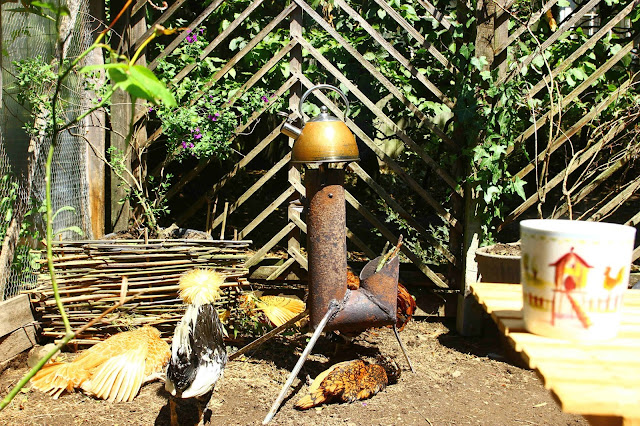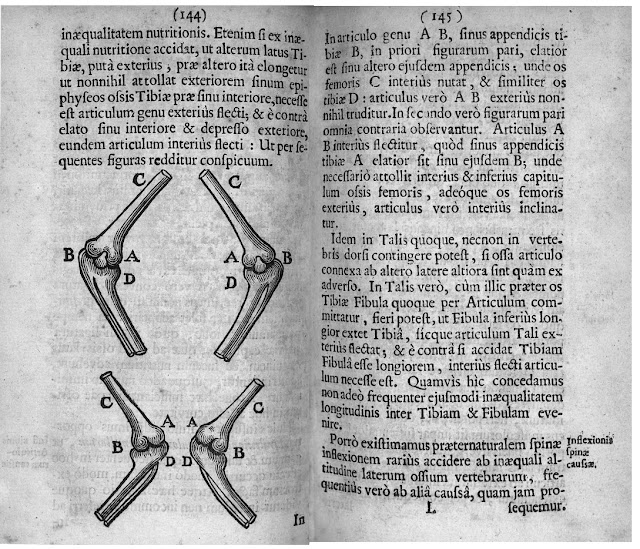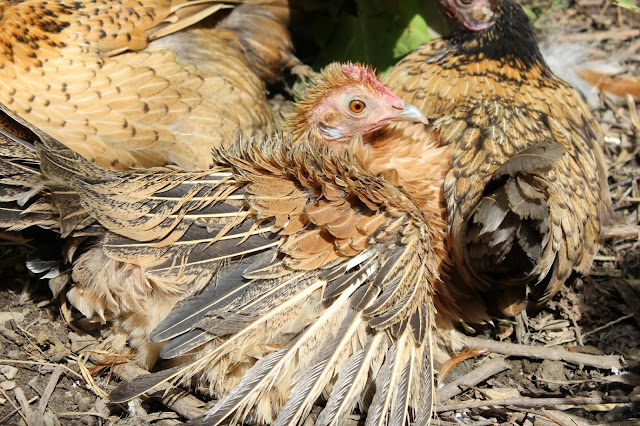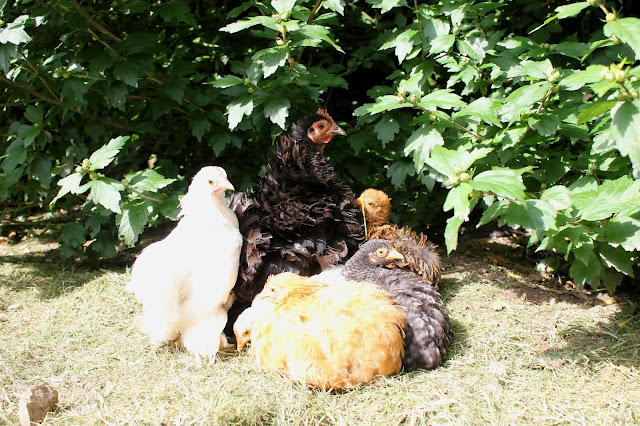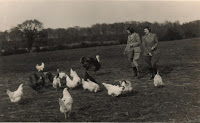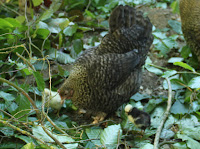Why do Mad Dogs, Englishmen and Poultry go out in the Midday Sun?
There is no great body of research on the actual mechanism and optimum levels for vitamin D₃ in birds. As a general rule of thumb however, a laying hen needs an average daily requirement of 20 minutes of strong UVB light to instigate the process of creating, what is colloquially known as, the 'sunshine vitamin' for optimum laying health. Poultry, in my experience, respond automatically to strong light sources and heat. It is as if they know this to be their best chance of getting maximum UVB light in the shortest possible period and which will leave them more time in the day for important activities like eating! Even when I have filmed birds under lights indoors, a bird lying on its side being investigated for mites, will simultaneously strike a sunbathing pose as the spot lights come up. Below you can see Bungle and her friends taking advantage of two heat sources, the sun and our newly created 'J' Rocket Stove - "The Rooster Rocket". I'm not sure about the amount of D₃ Bungle can expect to create from the stove but she is certainly taking no chances on losing out on any potential availability!
In fact although a Polish hen and well able to cope in the coldest of weather, Bungle is always ready to soak up the sun, no matter the location: from a friend's garden..
...to a day on the beach...
A Quick Dip into History
It was two members of the then newly formed Royal Society, Francis Glisson and Daniel Whistler, the former in his treatise De Rachitide, (1650) (below) and the latter in his PhD thesis in 1645, who first described, as a distinct disease, the bone deforming condition of rickets.
Two centuries later the Polish chemist and physician, Jędrzej Śniadecki, made what to some seemed a startling hypothesis, based on his observations of both city and country-dwelling children, that exposure to sunshine was the defining factor as to whether or not the children succumbed. A century later Vitamin D was identified, with 7-dehydrocholesterol, the precursor to Vitamin D₃ (aka provitamin D₃), being isolated in 1935. However, the full potential and importance of Vitamin D₃ in the maintenance of the physical and nervous systems of humans, animals and birds is still not fully understood today. One thing is certain though, that Vitamin D₃'s influence goes far beyond that of skeletal structure and its attendant conditions and in birds also further than in the creation and viability or otherwise of the shell. Furthermore, it is only in recent years that we have begun finally to appreciate the critical role D₃ plays in gut health and thus in the maintenance of a fully functioning immune system.
Is Vitamin D a Vitamin?
Well the answer to that one is initially that there are five forms of Vitamin D, each denoted by a subscript numeral but in most cases when we refer to Vitamin D we are referencing D₂ and D₃
The general consensus has been that, for all but a few species, vitamin D₂ and D₃ are equally as potent. For poultry and other birds and a few of the rare mammalian species that have been studied, including some New World monkeys, by weight vitamin D₃ is much more effective than D₂. Recent evidence indicates that in humans, for example, vitamin D₂ has only 25%-30% of the biological activity of vitamin D₃ (Armas et al., 2004).
Furthermore Vitamin D₃, when it is formed on the skin is not a vitamin it is a prohormone, which is converted in the liver and kidneys into a hormone. This may also explain our still limited understanding of the how and why D₃ has such a wide-ranging and crucial role on a wide raft of health related issues, from weight levels and mood swings to bone structure, immune system function and disease prevention.
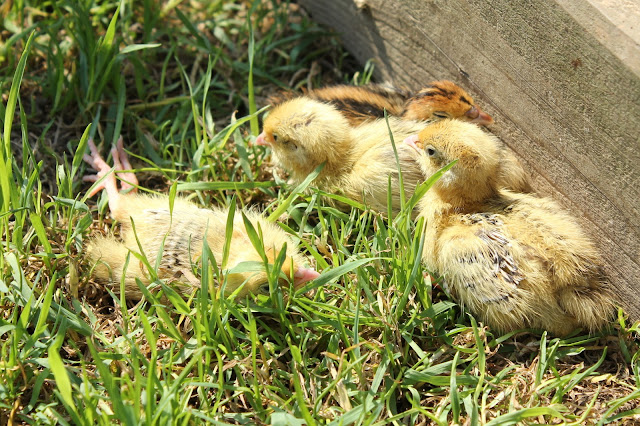 |
| Quail Chicks Soaking Up Some Rays |
The general consensus has been that, for all but a few species, vitamin D₂ and D₃ are equally as potent. For poultry and other birds and a few of the rare mammalian species that have been studied, including some New World monkeys, by weight vitamin D₃ is much more effective than D₂. Recent evidence indicates that in humans, for example, vitamin D₂ has only 25%-30% of the biological activity of vitamin D₃ (Armas et al., 2004).
Furthermore Vitamin D₃, when it is formed on the skin is not a vitamin it is a prohormone, which is converted in the liver and kidneys into a hormone. This may also explain our still limited understanding of the how and why D₃ has such a wide-ranging and crucial role on a wide raft of health related issues, from weight levels and mood swings to bone structure, immune system function and disease prevention.
Vitamin D The Vexed Question of the Mechanism of Absorption
According to one theory, the secretion of the Uropygial or preen gland contains 7-dehydrocholesterol. After the oil has been spread over the body by the action of the bird preening/oiling its feathers, the bird then sunbathes and the compound
is converted by high energy ultraviolet b photons (UVB) into provitamin D₃ (Cholecaciferol). When the bird then grooms itself, it ingests
the oil thus the provitamin D₃, which is then transformed in the liver and kidneys to
Vitamin D₃ (Calcitriol).
Others maintain that the provitamin D₃ is taken in through the exposed parts of the bird, such as the face and legs and there, as in humans it is held on the surface in the oil on the skin and then is slowly absorbed through the epidermis into the body. This school cites the fact that much of the provitamin D₃ on a bird is found on the legs and thus the oiling of the feathers serves some other purpose.
I like the first suggestion, it makes better sense to me on several counts, most importantly that the second theory limits the amount of provitamin D₃ access severely for those with beards/muffs and crests and also those with heavily feathered feet and legs, such as the Cochin family above and my Polish mother and son, left. I have furthermore, observed my birds oiling their legs from the preen gland, so that in itself would suggest why there would be a presence of provitamin D₃ on the legs. I've also noted that many papers refer to the bird spreading the oil with its beak, which does incur a lot of work to get the whole area covered and omits areas where the beak can not reach. However, I have also seen many of my birds directly applying oil for example, to the side and top of the head in a back and forth motion from the uropygial wick, the feathery brush like tuft covering the uropygial gland.
 I also like the idea of birds consuming the provitamin D₃ from the feathers and it is also borne out by my observations of my birds and by the fact that over the years I have witnessed individual birds, particularly recently purchased exhibition birds, grooming members of my outdoor, sun-worshiping flock. Above is a Silver, Black-laced Polish I bought at exhibition, I named her 'The Hairdresser Hen', as she spent her first weeks here preening my other birds. I am guessing that she was not just being friendly and forming bonds, although that may be part of the contract but that she was also profiting from the other's ability to make D₃. This could be something she may not have been able to do if her previous diet had been short of good fats and/or because she was trying quickly to up her reserves as I bought her in the Autumn!
I also like the idea of birds consuming the provitamin D₃ from the feathers and it is also borne out by my observations of my birds and by the fact that over the years I have witnessed individual birds, particularly recently purchased exhibition birds, grooming members of my outdoor, sun-worshiping flock. Above is a Silver, Black-laced Polish I bought at exhibition, I named her 'The Hairdresser Hen', as she spent her first weeks here preening my other birds. I am guessing that she was not just being friendly and forming bonds, although that may be part of the contract but that she was also profiting from the other's ability to make D₃. This could be something she may not have been able to do if her previous diet had been short of good fats and/or because she was trying quickly to up her reserves as I bought her in the Autumn!In Conclusion - the Power of the Sun & Food Working in Synergy
As previously
mentioned, in my articles on external parasites, it is important for us to understand how many vitamins and minerals in our foods work in synergy in the body, both to enable it to function at optimum and also to prevent disease and other health-threatening conditions. This is why I always like my birds to get their nutrition from a wide variety of foodstuffs, from which they can choose their diet because supplementing with anything may in fact cause or aggravate rather than ameliorate the problems. I'm thinking here in particular of calcium and the balance of other vitamins (including Vitamin D₃) and minerals such as magnesium which are involved in calcium's transport and assimilation into the correct location in the bone. Just feeding a bird calcium in a prepared food (rather than letting it pick up as much or as little as it needs in the way of oyster shell from its environment), doesn't allow the bird to self-regulate.
Above, bananas and chickweed a winning combination for magnesium content. Deficiency in one foodstuff or in the case of provitamin D₃ limited access to UVB light, may cause a whole myriad of interrelated health problems. A recent study in 2013, showed that a deficiency in magnesium can shut down the pathway by which the body both assimilates and metabolises vitamin D₃ (Deng et al., 2013). Thus the blocking of the preen gland with excess keratin production due to Vitamin A deficiency, will in turn cause an interruption in the
ability to manufacture D₃ from sunlight. Similarly a lack of good fats in the diet, obtainable through an invertebrate diet would cause a breakdown in the mechanism by which D₃ is created. Therefore, the evidence of external
mites will be a good indication that the pathway of
7-dehydrocholesterol has been compromised and thus the bird may develop
all kinds of conditions symptomatic of D₃ deficiency. Here's the film:
It all helps to keep me going!
Until next time, all the very best from Normandie! Sue
Thanks
for dropping by and do feel free to share experiences or ask for
further information in the comment section. If you have enjoyed this
piece and found it
useful think about sharing it with your family and friends, on social
media and also maybe about joining this blog
and/or subscribing to my Youtube channel or even supporting us on
Patreon or
It all helps to keep me going!
Until next time, all the very best from Normandie! Sue
RELATED ARTICLES
Food for Free. Fabulous Forage Part 1 Grass
For
centuries farmers and homesteaders raised poultry on a forage-based
diet supplemented only by a handful of grain and the occasional..read more
Food for Free. Fabulous Forage Part 2 Chickweed
Stellaria media an incredible food and medicinal for poultry, an in-depth look at this ubiquitous weed..read more
How to make an artistic 'J' Rocket from scrap - Rooster/Cockerel Rocket
This year I decided to improve the design of our old rocket stove by changing the pipe
configuration to a 'J' - tube rocket. The advantage of this...read more
Food for Free. Fabulous Forage Part 3 Tree Fodder & Tree Hay
The idea of tree fodder is inextricably linked with the changing landscape, the full domestication of animals, the concept of farming and the clearance of the forests... read more
Food for Free. Fabulous Forage Part 4 Roses for Food & Forest
For me the rose is the quintessential forest garden plant, from canopy to ground cover there are so many to choose from ... read moreFood for Free. Fabulous Forage Part 5 Rose Petals
One of the main roses I use for both cooking, medicinals and which my hens very much enjoy is, not surprisingly, rosa gallica Officinalis, or The Apothecary Rose... read moreQuail, Chickens & Watercress - A winning combination
So what is it that makes watercress so special? It's not
just the quantity of individual vitamins and minerals but the...read more
Contrary to its common name nasturtium officianale does not need to be grown in
water, moist soil is fine. However, it does give the watercress...read more

